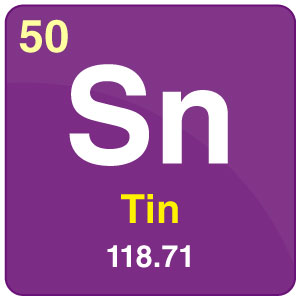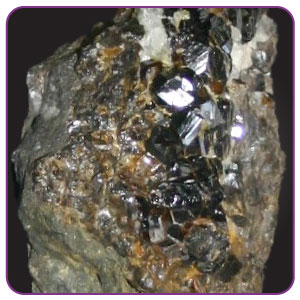
| Symbol | Sn |
| Atomic Number | 50 |
| Atomic Mass | 118.71 g.mol -1 |
| Discovery | approx 2100BC |

Table of Contents
- Chemical Properties of Tin
- What is Tin (Sn element)?
- Uses of Tin (Sn element)
- Properties of Tin
- Allotropes of Tin (Sn element)
- Health Effects of Tin
- Recommended Videos
- Frequently Asked Questions – FAQs
Chemical Properties of Tin
| Group | 14 | Melting point | 231.928°C, 449.47°F, 505.078 K |
| Period | 5 | Boiling point | 2586°C, 4687°F, 2859 K |
| Block | p | Density (g cm−3) | 7.287 |
| Atomic number | 50 | Relative atomic mass | 118.710 |
| State at 20°C | Solid | Key isotopes | 120Sn |
| Electron configuration | [Kr] 4d10 5s2 5p2 | CAS number | 7440-31-5 |
| ChemSpider ID | 4509318 | ChemSpider is a free chemical structure database. | |
What is Tin (Sn element)?
- Tin or also called as Stannum in Latin with the atomic number 50 belongs to group 14 of the periodic table.
- Tin shows a chemical similarity to both of its neighbours in group 14, germanium and lead, and has two main oxidation states, +2 and the slightly more stable +4.
Uses of Tin (Sn element)
- It is used in tin plating, coating and polishing as it has a high resistance to corrosion
- It is used in the soldering of steel as it possesses high magnetic strengths and lower melting points
- It is also used in the manufacture of other alloys such as bronze and copper
- It is used as a reducing as well as a dyeing agent for glass, ceramics, and sensors
- In the shipping industry, it is used as an anti-fouling agent for boats and ships to prevent them from barnacles
- In dental applications, it is employed in some products in the form of stannous chloride (SnCl2)
- It also has its applications in the electrodes of batteries such as in the Li-ion batteries.
- It is widely used in the manufacture of food containers made of steel.
Properties of Tin
- It has an atomic number of 50 and is known to be a soft and malleable metal in a bluish-white appearance.
- About two parts/million number of the earth’s crust is said to be composed of tin.
- This element exists in the form of igneous rocks of the Earth’s crust at about a concentration of 0.001 percent, which is assumed to be scarce rather than rare;
- It is abundantly found like the other elements such as cobalt, copper, nickel, cerium, and lead.
- At room temperature, there is no effect of oxygen and water over the tin. It is also resistant to corrosion. This is the reason it is used as a coating for other metals.
- At higher temperatures, the metal forms its oxide when reacted with water and oxygen.
- Tin has about two different forms (or allotropes) which are in the form of white and grey.
- The grey metal changes its colour to white at temperatures of above 13.2 °C and very rapidly above 100 °C. This metal has about 10 naturally occurring isotopes with different mass numbers.
Allotropes of Tin (Sn element)
- The three allotropes of tin are Grey tin (cubic), white tin (tetragonal) and white tin (rhombic).
- When white tin converts to grey tin, an increase in volume takes place.
- White tin is an ordinary form, silver-white in colour and harder than lead. White tin is highly malleable and ductile.
- It can even be moulded to thin foils.
- The crackling sound generated during bending of tin rods is called “Tin Cry”.
- At -50oC the conversion of white tin to grey tin is very fast.
- The grey tin has lower density brittle and can easily be powdered.
- In very cold climates, the crumbling of grey tin to powder form is called Tin disease or Tin plague.
Health Effects of Tin
- Sn element in organic form is most dangerous to health. It can cause severe effects in humans such as eye and skin irritations, headaches, sickness, dizziness, breathlessness, severe sweating along with urination problems.
- The main drawback is that the metal is not completely biodegradable. Hence it can have an impact on the environment.
Recommended Videos

Frequently Asked Questions – FAQs
Is the element Sn a metal?
Sn element (Sn), a chemical element belonging to the carbon family, is in the periodic table group 14 (IVa). It is a smooth, silvery white metal with a bluish Sn element, an alloy of copper known to the ancients in bronze. Sn element is commonly used as food containers for the plant elements of steel bottles, in metals used for bearings and in soldering.
What is the Sn element used in?
Sn element (Sn), a chemical component belonging to the carbon family, periodic table group 14 (IVa). It is a smooth, silvery white metal with a bluish Sn element Ge, an alloy with copper known to the ancients in bronze. Sn element is commonly used as a food container for Sn element steel containers, in metals used for bearings, and in soldering.
Is Sn element harmful to humans?
In living organisms Sn element has no established natural biological function. The animals and humans don’t consume it easily. The low toxicity is important for the widespread use of Sn elements in foodstuffs and canned food. The toxic effects of Sn element compounds are based upon interference with the metabolism of iron and copper.
How is Sn element obtained?
Sn element is obtained primarily from mineral cassiterite (SnO2), and is extracted in a carbon furnace by road Sn element cassiterite. Sn element constitutes only about 0.001 percent of the Earth’s crust and is primarily mined in Malaysia. The Grey Sn element slowly turns at temperatures above 13.2 ° C into the second form of Sn element, the white Sn element.
Why is Sn element so important?
Sn element prevents corrosion, and is used on other metals as a protective coating element. The most common example of this feature is probably the Sn element cans. Indeed a Sn element can be made of steel. To prevent the steel from rust element, a thin layer of Sn element is added to both inside and outside the can.
Read more:

Comments